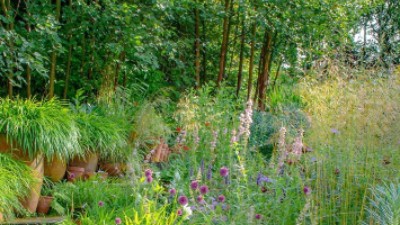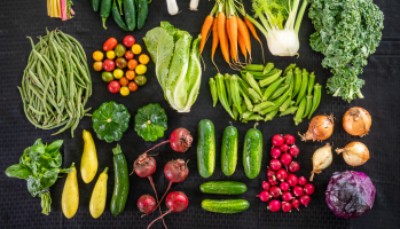 bringing nature, nurseries and gardeners together June 11, 2021
|
|
How to propagate an olive tree: with prices of arbequina olive trees hovering in the $50 - $60 level, maybe it's time to think about growing your own. Cut an 8" young branch, dip in rooting hormone, and plant in a mixture 50% peat and sand. Complete details from the folks at Oliviada ❦

Future nature + superbloom: Nigel Dunnett is a UK expert on naturalistic planting design favored by disciples of Piet Oudolf. At 3 p.m. June 15 (via Zoom) Nigel, a professor at the University of Sheffield, will give a 75 minute talk on this subject. $20. Register here: New Perennialists Dunnett's business: Pictorial Meadows ❦
_____________________________________________________
Support the Austin Garden! This newsletter relies entirely on donations. Please consider making a donation today. Many thanks ; - ) PayPal ❦

Johnson's Backyard Garden: the recent May/June rains have created some difficulties for this amazing organic farm, as it works tirelessly to create its weekly CSA boxes of goodness for central Texans. Ada Broussard reports: J.B.G. organic ❦
_____________________________________________________
Fifty two gardens: enter a dreamworld of clipped boxwood hedges, tiered fountains, lemon trees and Italian cypress in this collection of classic garden designs from Architectural Digest ❦

Central Texas Gardener: an interview with Jennifer Jewell from the podcast Cultivating Place. Writes Linda Lehmusvirta: "Elevating local-to-global stories of community activism, social justice, and environmental healing, she connects us to gardening’s cultural and spiritual value." KLRU ❦
_____________________________________________________
A fan writes: "Just want to say thanks for keeping this newsletter alive with good information and inspiration. How I wish y’all (It's About Thyme) were back!" - Ann W.

Hancock golf course-to-park: there's no kite-flying or picnicking upon the great lawns of this central golf course right now. But there could be. Please join us to help heal the land and open up what will someday be a crown jewel in Austin's park system. (painting: Linda Anderson) Hancock Conservancy ❦

I believe a leaf of grass is no less than the journey-work of the stars. - Walt Whitman
For some reason gardeners often overlook ornamental grasses. Grass is for mowing, people say… and when visiting a nursery you normally want to buy a tree, vegetables, a perennial, or something that will yield flowers. Not just a clump of grass.
But as you drive around Travis and Hays counties, keep your eyes open and observe how creative landscape designers – and home gardeners – are using grasses as soft boundaries, or planting them in big groups, or using them as a screen.
The good news about these grasses is that they are versatile, easy to grow, and provide beautiful fall and winter color for the garden.
They are also remarkably adaptable to different sun conditions and once established they can survive a drought. Gardeners really don’t have to do much to make them flourish.
Outside of a few spring flowering grasses, most produce their showy seed heads in the fall and add foliage color throughout the winter.
Our only garden chores are to water infrequently during extended drought and to cut back the winter foliage when new growth begins to show in the spring. Here are some of my favorite choices for central Texas landscapes:
The Muhlenbergias
This native genus has many grasses that are showy, easy to grow, and easy to find in local nurseries.
Coastal muhly grass (Muhlenbergia capillaris), also known as “Gulf” muhly, grows to a height and width of 3 feet. Its gray-green foliage produces pink, mist-like, seed heads in the fall, that are striking, especially when backlit by the sun.
Big muhly (Mulenbergia lindheimeri) produces feathery tan colored seed heads in the fall on top of foliage that is bluish green. Big muhly grows to a height and width of four feet. It grows throughout the Hill Country and is extremely hardy. Deer, cows, horses, goats, and sheep won’t eat it.
Bamboo muhly (Mulenbergia dumosa) is the largest of the muhly grasses, growing over four feet with bamboo-like feathery foliage which turns the color of straw in the winter months. It should be cut back in the spring when new growth appears. Unlike spreading bamboo, it isn’t invasive. It stands alone as a beautiful specimen.
The Maidengrasses
In the genus Miscanthus, there are 15 varieties of hardy ornamental grasses that can be used for accent, borders, and screens. All have pretty seed heads in the fall and winter, and should be cut back in the spring. A few varieties to look for are standard and dwarf maidengrass, adagio, cabaret, morning light, and porcupine or zebra grass.
The Fountain Grasses
In the genus Pennisetum, these also show many forms and colors. They range in size from the dwarf fountain grass that grows under two feet to the standard fountain grasses that get to five feet or taller.
One of the most outstanding of the fountain grasses is rubrum or purple fountain grass. It can grow to five feet and has reddish-purple foliage with purple seed heads. Rubrum needs to be cut back after the first freeze and mulched well.
Its winter hardiness is not as good as the other grasses. In contrast to purple fountain grass is a variety called ‘moudry’ which has black seed heads and grows under two feet.
The ornamental grasses can give color throughout the year, are easy to grow, adaptable to varying light conditions, deer resistant, and very drought tolerant. They are a great choice for our water stressed conditions.❦
|
 It's About Thyme Legacy Publications.
Contact newsletter editor Darrel Mayers with any ideas for articles or interesting links at internationalrain@yahoo.com (hitting 'reply' to this email won't work) |
|
|